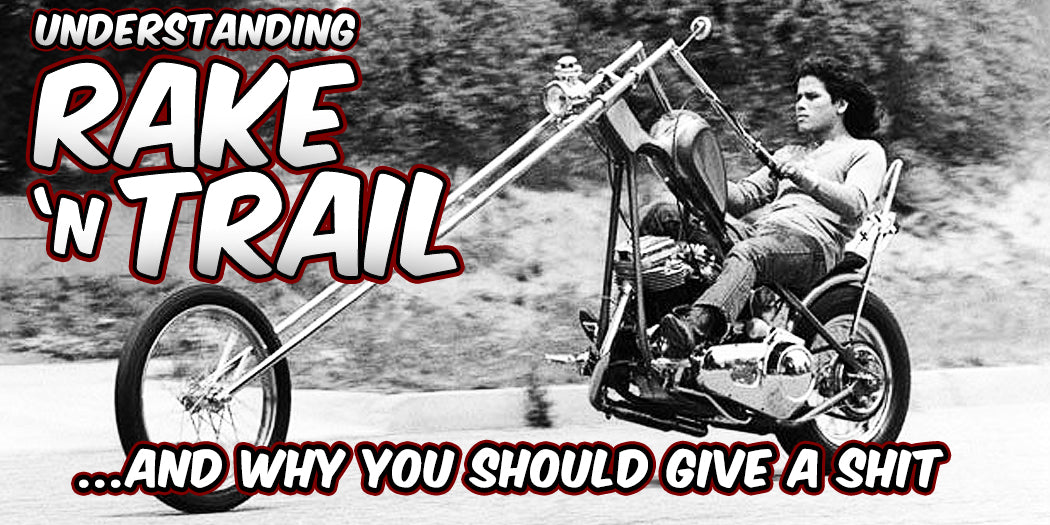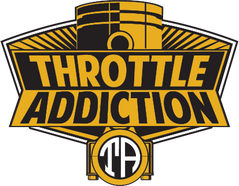
Understanding Rake and Trail
Imagine yourself sitting in front of a couple of bikes, one facing the other, and carefully observing the differences in them. You notice a slight difference in the angles of the springer forks. Then you look at the center of the two-tone front wheel and you see that the wheels are placed differently within the forks. Those two differences are called rake and trail and they are two of the most important suspension geometry features, responsible for the handling and feedback.
Not What It Seems To Be: Rake
I’ll start with the most noticeable of the two, and that is the rake. You’ve surely experienced the effects it has on handling, even if you’ve never ridden a motorcycle. You know how those old-school bicycles have almost vertical forks and handle very twitchy, while, say mountain bikes, have the forks at an angle and handle like a dream. Exactly that fine line between life and death is the result of rake angle.
I’ll admit, it may seem that rake angle is the fork angle, but it’s actually not. It’s the angle, in degrees of the steering neck on the frame, relative to the vertical axis.

The way steering on a motorcycle works is like this; you apply a certain amount of force that acts on the fork through the handlebars. Rake comes into play with the angular distribution of the applied force.
The lower the rake angle, the less force you need to turn, since the wheels is closer to you. This is perfect for small turning radiuses because of the shorter wheelbase. The drawback is that the bike becomes unstable at high speeds. On the other end of the spectrum is increasing the rake angle. The wheel is further away from you and you need to apply more force in order to turn. You get a longer wheelbase and overall a much safer bike that’s stable at high speeds. On the other hand, your turning radius is enlarged and you’re less stable at low speeds due to the bike’s inability to support itself.
Rake greatly depends on the type of motorcycle you’re riding. Tourers and cruisers are more laid back, with about 29 and 32 degrees, while choppers are at the edge with about 45 degrees. For example, all the old-school Harley Touring models had a 26 degree rake, giving them a slightly faster response. Most likely you’ll find the rake angle to be anywhere from 22 to 32 degrees, as those angles are tried and proven in terms of stability, response and looks as well.
It’s obvious that having too little or too much rake angle can be disastrous, so it’s mandatory to set it up just right. More importantly, it’s crucial that the bike is set up to suit your riding style, as we’re all different and what works for me may not work for you.
Same Outcome, Different Approach: Trail
With the mystery behind rake cleared, let’s talk about trail. Even though trail has a very similar effect on handling as rake does, the way that effect is realized is completely different. You won't be able to measure trail with a protractor, as the amount of trail a motorcycle has is displayed in distance units as opposed to degrees for rake angle. Before we dive into the technical side of things, check out the image below for a few seconds prior to reading on.

Looking at the graphic above, it’s easy to see that trail is basically the distance from the ground point perpendicular to the center of the wheel and the imaginary line that matches the rake angle.
It may not seem so, but trail has a more dramatic effect on handling than rake. Both change the wheelbase, but trail does it directly, as you’re acting upon the position of the wheel itself, instead of it moving because of the change in angle. As a result, you have to be very careful when you adjust trail as you can easily mess up the handling. The basic principle is the same as with rake. More trail gives you more wheelbase and you get a stable bike at high speeds and lazy at low speeds. Less trail gives you the direct opposite.
Trail can also be negative, but that’s achieved with custom forks or raked trees, and you should avoid it at all costs because it gives you a false sense of security. Yes, you’ll get a bike that handles gorgeously around town but push it a bit and it becomes very unstable as you’re making it more sensitive to your steering input.
As in the case with rake, the amount of trail varies with the type of motorcycle. The 3.5-6 in range is what the experts say is the perfect amount. The aforementioned Harley Tourers for example sport a 6.2 in trail. Keep in mind that trail has to be in sync with the rake angle, as the combination of the two can make or break your setup.
Understanding The Importance Of Rake And Trail
Adjusting rake and trail can be tricky but get it right and you’re golden. Basically, it’s a matter of trial and error in the search for the perfect spot where you get excellent stability with good low speed turning capabilities. Of course, there are many more factors that pitch into the handling topic, but rake and trail are the backbone of the subject.
